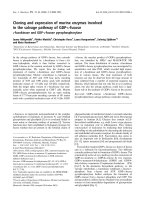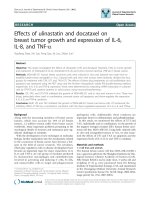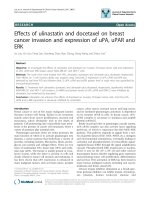Study on some histopathological features and expression of some immunohistochemical markers in prostatic carcinoma
Bạn đang xem bản rút gọn của tài liệu. Xem và tải ngay bản đầy đủ của tài liệu tại đây (527.24 KB, 6 trang )
Journal of military pharmaco-medicine n08-2017
STUDY ON SOME HISTOPATHOLOGICAL FEATURES AND
EXPRESSION OF SOME IMMUNOHISTOCHEMICAL MARKERS
IN PROSTATIC CARCINOMA
Vi Thuat Thang*; Tran Ngoc Dung*; Nguyen Dinh Tao**
Nguyen Ngoc Hung*; Tran Ngoc Anh**
SUMMARY
Objectives: To determine some histopathological features and evaluate the expression of some
IHC markers in prostate carcinoma (Pca). Subjects and methods: Histopathological study was
performed on 84 specimens by using hematoxylin and eosin (H.E) stained tissue sections. IHC
study was performed on 33 specimens by using IHC stained tissue sections with PSA, CK34βE12,
p63, CK7, CK5/6, actin monoclonal antibodies. Results: Prostatic adenocarcinoma accounted for
96.4% (acinar type was the most common) and urothelial carcinoma of the prostate accounted for
3.6%. Gleason scores 5 - 7 were the most common. Of the 84 patients, 60 (73.2%) had high grade
prostatic intraepithelial neoplasia (HGPIN) associated adenocarcinoma. There were 39% of
adenocarcinoma with perineural invasion and 53.7% of adenocarcinoma with mucinous secretions.
IHC showed 31 cases (94%) of Pca which were positive for PSA and 2 cases (6%) of urothelial
carcinoma of the prostate were negative for PSA. The lower Gleason grade was stronger positive for
PSA was and vice versa. All the tumor cells were negative for 34βE12, p63, CK7, CK5/6 and actin.
Conclusion: Our data indicate that most of Pca are prostatic adenocarcinoma and Gleason scores
5 - 7 are the most common scores. HGPIN is strongly associated with adenocarcinoma. Other
features are commonly seen in prostatic adenocarcinoma which are blue-tinged mucinous
secretions and perineural invasion. IHC shows all of prostatic adenocarcinomas are positive for
PSA, urothelial carcinoma of the prostate is negative for PSA. The staining intensity of the tumor
cells for PSA is stronger in the lower grade adenocarcinomas and vice versa.
* Keywords: Adenocarcinoma of the prostate; Immunohistochemistry.
INTRODUCTION
Prostatic carcinoma is one of the
malignant tumours and often found in
men over the age of 65. Nowadays, this
kind of tumour has the tendency to increase
dramatically in almost every country
around the world. Histopathologically,
adenocarcinomas of the prostate range
from well-differentiated gland forming
cancers, where it is often difficult to
distinguish them from benign prostatic
glands, to poorly differentiate tumours,
difficult to identify as being of prostatic
origin [8]. Currently in about two-thirds of
these difficult cases, an appropriate
diagnosis can be made due to IHC stains
with the use of antibodies [4]. In Vietnam,
the studies on histopathological features
and the expression of IHC markers in
carcinoma of the prostate are not adequate
to the demand [1]. The aim of this study is:
To determine some histopathological
features and evaluate the expression of
some IHC markers in Pca.
* 103 Military Hospital
** Vietnam Military Medical University
Corresponding author: Vi Thuat Thang ()
Date received: 23/03/2017
Date accepted: 27/09/2017
222
Journal of military pharmaco-medicine n08-2017
SUBJECTS AND METHODS
1. Subjects.
Eighty four consecutive prostate glands
operated by using transurethral resection
of the prostate (TURP) at Urology of
103 Military Hospital from June, 2008 to
July, 2017.
2. Methods.
Specimens were fixed in 10% neutral
buffered formalin, embeded in paraffin
and cut on the microtoma. Tissue
sections were stained with H.E and IHC
stained with the use of PSA, CK5/6,
CK34βE12, p63, CK7, actin monoclonal
antibodies. The results were presented
and discussed.
Tissue sections of 33 cases were
IHC stained with use of PSA, CK5/6,
CK34βE12, p63 and actin monoclonal
antibodies, in which there were 31 cases of
adenocarcinoma and 2 cases of urothelial
carcinoma of the prostate.
- Determine the ratio of prostatic
carcinomas which were positive for PSA,
CK34βE12, p63, CK7, CK5/6 and actin.
- Distribute staining intensity of tumor
cells for PSA according to Gleason grade.
RESULTS AND DISCUSSION
1. Distribution of patients’ age.
Table 1: Distributed results of Pca among
age group (n = 84).
Age group
No. of patients
(n = 84)
Ratio (%)
40 - 49
1
1.19
50 - 59
4
4.76
60 - 69
20
23.81
70 - 79
36
42.86
≥ 80
23
27.38
Total
84
100%
* Distribution the age:
Ages of patients were divided into
5 groups with the gap of 10 years
(< 50, 50 - 59, 60 - 69, 70 - 79 and ≥ 80).
* Study on histopathology:
- Determine the types of histopathology
of the Pca according to the 2004 WHO
histological classification of tumours of the
prostate.
- Evaluate the association between
adenocarcinoma and HGPIN.
- Grade the adenocarcinomas according
to the Gleason grading system.
- Group Gleason scores into diffentiation
categories.
- Determine some histopathological
features of prostatic adenocarcinoma.
* Study on the expression of some IHC
markers in prostatic carcinoma:
This table showed the incidence of Pca
increased with age group. The 70 - 79
age group was the highest with 42.86%,
the 40 - 49 age group was the lowest
with 1.19%. These results showed that
prostatic carcinoma was rarely found in
men below the age of 50 [1, 6, 8]. Our
results of distributed Pca among age
group are the same as the outcome of
study carried out by Nguyen Van Hung [1],
Nguyen Buu Trieu [2] and others [7].
223
Journal of military pharmaco-medicine n08-2017
2. Study on histopathology.
Table 2: Determination of types of
histopathology of the Pca according to the
2004 WHO histological classification
(n = 84).
Types of histopathology
No. of
patients
Ratio
(%)
Adenocarcinoma
Acinar adenocarcinoma
Dductal adenocarcinoma
Urothelial carcinoma
Squamous carcinoma
Basal cell carcinoma
82
80
2
2
0
0
96.4
97.6
2.4
3.6
Total
84
100%
This table showed adenocarcinoma
accounted for 96.4% (in which acinar
adenocarcinoma was 97.6%, ductal
adenocarcinoma was 2.4%) and urothelial
carcinoma of the prostate accounted for
3.6%. These results were the same as the
results found by Nguyen Van Hung [1]
and others.
Table 3: Association between
adenocarcinoma and HGPIN (n = 82).
Histopathology
Adenocarcinoma is
associated with HGPIN
Adenocarcinoma is not
associated with HGPIN
Total
No. of
patients
Ratio
(%)
60
22
73.2
26.8
82
100 %
Adenocarcinoma associated with
HGPIN and accounted for 73.2%,
much higher than adenocarcinoma,
did not associate with HGPIN (26.8%).
Nguyen Van Hung [1] also found that
76.2% of prostatic carcinoma contained
HGPIN. Clinical significance of HGPIN
showed strong association with Pca [5].
224
HGPIN was a predictive factor which was
valuable in the diagnosis of adenocarcinoma
of the prostate, especially HGPIN with
adjacent atypical glands (PINATYP) [8].
HGPIN in needle biopsy tissue was a
risky factor for the subsequent carcinoma
detection after re-biopsy [1, 2, 5, 9].
Table 3: Grouping Gleason score into
diffentiation categories (n = 82).
Differentiated
grade
Gleason
score
No. of
patients
Ratio
(%)
Well differentiated
Moderately
differentiated
Poorly
differentiated
2-4
5-7
14
58
17.1
70.7
8 - 10
10
12.2
82
100%
Total
Two cases of urothelial carcinoma of
the prostate were not included in this
scoring system. Gleason score tumors
5 - 7 were the highest ratio (70.7%), Gleason
score tumors 2 - 4 and 8 - 10 were 17.1%
and 12.2%, respectively. These results
were the same as the study carried out by
Nguyen Van Hung [1], Bostwick, Oesterling,
Zincke [1, 3, 5, 10].
Table 5: Distributed ratio of adenocarcinomas
according to malignant specific features
(n = 82).
Malignant specific
features
Number
Ratio
(%)
Perineural invasion
32
39%
Mucinous fibroplasia
9
11%
Glorumerulation
10
12.2%
2 or 3 of malignant specific
features
6
7.3%
No malignant specific
features
25
30.5%
82
100%
Total
Journal of military pharmaco-medicine n08-2017
The table showed adenocarcinoma
with perineural invasion was found in
39% of cases, adenocarcinoma with
glorumeration and mucinous fibroplasia
were found in 12.2% and 11%, respectively.
Adenocarcinoma with 2 or 3 malignant
specific features were found in 7.3% of
cases while adenocarcinoma with no
malignant specific features were found in
30.5% of cases. There were only 3
features that are in and of themselves
diagnostic of cancer. These were perineural
invasion, mucinous fibroplasia and
glorumeration. Perineural invasion
specimens by prostate cancers were seen
in radical prostatectomy specimens in
75 - 84% of cases. Most studies indicate
that its pesesence corellated with
extraprostatic extension (38 - 93%).
Recent data suggest that this finding
may indipendently predict lymph-node
metastasis and prognosis after surgery
[8].
Table 6: Distributed ratio of adenocarcinoma
according to intraluminal features (n = 82).
Intraluminal features
Number
Ratio (%)
Crystalloids
8
9.7%
Blue-tinged mucinous
secretions
44
53.7%
Crystalloids and
mucinous secretions
18
22%
No crystalloids and
mucinous secretions
12
14.6%
82
100%
Total
Crystalloids were found in 9.7% of cases,
blue-tinged mucinous secretions (53.7%),
crystalloids and mucinous secretions (22%),
no crystalloids and mucinous secretions
(14.6%).
Crystalloids, despite not diagnostic of
carcinoma, were more frequently found in
low grade cancer than in benign glands
[11]. Young [9] also showed that the
incidence of crystalloids in the adenocarcinoma
ranged 10 - 62%. Blue-tinged mucinous
secretions seen in H.E stained sections
were additional finding seen preferentially
in cancer, especially low grade cancer [8].
Fig.1: Well- differentiated
adenocarcinoma, Gleason grade 2.
(Arrow: mucinous secretions)
(No. S2835 x 200.HE)
Fig.2: Poorly differentiated
adenocarcinoma, Gleason grade 4.
(Arrow: perineural invasion)
(No.S3475 x 400.HE).
225
Journal of military pharmaco-medicine n08-2017
3. Study on immunohistochemistry.
Table 7: Ratio of Pca which were positive for PSA, 34βE12, p63, CK7, CK5/6 and
actin (n = 33).
Type of marker
Number of positive cases
Ratio (%)
PSA
31/33
94%
34βE12
0/33
0%
p63
0/33
0%
CK7
0/33
0%
CK5/6
0/33
0%
Actin
0/33
0%
The study results were consistent with the findings of other studies [1, 4, 8].
Table 8: Staining intensity distribution of tumor cells with PSA according to Gleason
grade (n = 31).
Intensity
Number
(1+)
7
(2+)
15
(3+)
9
(4+)
0
Tổng
31
Grade 2
Grade 3
Grade 4
Grade 5
5
2
5
2
15
9
9
15
(Positive: +; Faint: 1+; Moderate: 2+; Strong: 3+; Very strong: 4+)
IHC showed tumor cells which were strong positive for PSA in the areas of Gleason
grade 2, moderate positive for PSA in the areas of Gleason grade 3, faint positive for
PSA in the areas of Gleason grade 4 and 5. The study results were consistent with the
findings of other studies. The finding is that the more the differentiated tumor cell is, the
stronger the positive intensity for PSA is and vice versa [1, 4, 8].
Fig 3: Gleason grade 2.
(Arrow: strong positive)
No. N3351 x200. PSA.
226
Fig 4: Gleason grade 3.
(Arrow: moderate positive)
No. N3351 x200. PSA
Fig 5: Gleason grade 4.
(Arrow: basal cells (2+) for
34βE12 in benign glands)
(No. N2519 x200. 34βE12).
Journal of military pharmaco-medicine n08-2017
CONCLUSION
* Histopathological features:
Prostate carcinoma is common in the
older men. Most of Pca are adenocarcinoma
in which acinar adenocarcinoma type is the
most common, ductal adenocacinoma is a
rare variant of prostatic adenocarcinoma.
Gleason scores 5 - 7 are the most common.
Adenocarcinoma is strongly associated
with HGPIN. Other features commonly
seen in prostatic adenocarcinoma which
are blue-tinged mucinous secretion and
perineural invasion.
* Expression of some immunohistochemical
markers:
IHC shows all of prostatic adenocarcinomas
are positive for PSA, urothelial carcinomas
of the prostate are negative for PSA. The
staining intensity of the tumor cells for
PSA are stronger in the lower grade
adenocarcinomas and vice versa. Tumor
cells are negative for CK34βE12, p63,
CK7, CK5/6 and actin.
REFERENCES
1. Nguyễn Văn Hưng. Nghiên cứu mô
bệnh học quá sản lành tính, tân sản nội biểu
mô và ung thư biểu mô tuyến tiền liệt. Luận
án Tiến sỹ Y học. 2005.
2. Nguyễn Bửu Triều, Nguyễn Kỳ, Trần
Đức Thọ. Các biểu hiện lâm sàng của ung thư
tuyến tiền liệt ở giai đoạn muộn. Chẩn đoán
và điều trị. Tạp chí Ngoại khoa. 1991, 1, tr.9-13.
3. Bostwick D.G. Prostatic intraepithelial
neoplasia. Urol (suppl). 1999, 34 (6), pp.23-27.
4.
Buchwalow
I.B,
W.
Böcker.
Immunohistochemistry: basics and methods.
Springer Science & Business Media. 2010.
5. Oesterling J.E, Brendler C.B, Epstein J.I
et al. Correlation of clinical stage, serum
prostatic acid phosphatase and preoperative
Gleason grade with final pathological stage in
275 patients with clinically localized prostate
cancer. J Urol. 1987, 138, pp.92-96.
6. Stanley L.Rbbins M.D. Pathologic basis
of disease. W.B. Saunders Company. 1974,
pp.1190-1198.
7. Tannenbaurn M, Galang C.F, Park C.H
et al. Dysplasia of the prostate, a precursor
lesion of prostatic cancer. Ann Urol. 1991,
pp.27-49.
8. John N. Eble, Guido Sauter, Jonathan I.
Estain, Isabell A. Sesterhenn. Pathology and
genetics of tumours of the urinary system and
male genital organs. IARCPress. Lyon. 2004,
chapter 3, pp.159-215.
9. Young R.H, Srigley J.R, Amin M.B,
Ulbright T.M, Cubillia A.L. Tumors of the
prostate gland, seminal vesicles, male urethra,
and penis. 3rd, Fascicle 28. Raven. 2000,
pp.1-344.
10. Zincke H, Farrow G.M, Myers R.P et al.
Relationship between grade and stage of
adenocarcinoma of the prostate and regional
pelvic lymph node metastases. J Urol. 1982,
128, pp.498-501.
227









